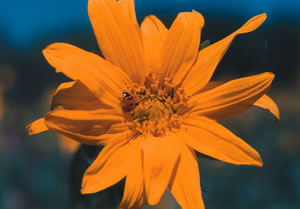 |
August is the month for thunderstorms and sunnies. Clear morning skies give way to afternoon thunder heads - huge cumulonimbus clouds the size -of Eastern-states. Whether or not it rains is another story, and as summer starts to fade away, drawn by the lure of short days and cool nights, only a few desert plants may be found in bloom. A majority of these plants are sunnies - members of the Sunflower Family (Asteraceae). One of the most conspicuous members of this group is rabbitbrush (Chrysothamnus nauseosus). The genus translates into “a golden _shrub” a fitting name for this large shrub that bears a blanket of golden flowers. The heavy-scented aroma of the leaves and flowers gives rise to the “nauseous” species name. Inside the plant’s stems is a milky latex which was, at one time, harvested and processed into a commercial grade of rubber. Native Americans collected the rabbitbrush flowers and made a golden-yellow dye that they used to color their cotton garments. Rabbitbrush grows in moist areas, often found near stream sides or roadways where they take advantage of the summer run off. Growing along the moist streambanks, two different goldenrods tag the redrock canyons with a splash of gold. The common goldenrod (Solidago canadensis) and western goldenrod (Solidago occidentalis) bear long plumes of yellow flowers. The leaves of goldenrod were harvested by Native Americans and brewed into a tea. This tea was used to treat intestinal disorders and to promote sweating in cases of fever.Big sagebrush (Artemisia tridentata) is another prominent member of this group that blooms in the late summer and grows in the dry upland areas or in the canyon bottoms. The species name is derived from the three-lobes on the leafs tip, “tridentata” means “three teeth.” The large shaggybarked shrubs have long plumes of compact flowers that attract a myriad of flying insects that act as pollinating ambassadors. An important winter browse plant for deer and elk, the past years of drought have taken their toll upon the sagebrush and left them in poor condition on many parts of the range. The leaves and flowers of big sagebrush are very fragrant, and one has only to smell the air after a late summer thunderstorm to known that sagebrush is present. Native Americans utilized this plant and its fragrant oils in a tea form to cure stomach disorders or as a dye, while the soft bark was used to pad craddleboards. Though considered a weedy species, the
common sunflower (Helianthus annus) rockets toward the sky
before it erupts into golden color. The large showy
flowers seem to track the path of the sun as it travels across
the sky, and this is habit relates to the derivation of the
genus name, “helio” for sun and “anthus”
for a flower. Reaching to six or eight feet in height, these
tall annuals have heart-shaped leaves that are rough to the
touch. A plethora of bees, wasps, butterflies and other insects
can be found moving over the central disk flowers, collecting
pollen and searching for nectar. Of course, their movement
transfers pollen between the flowers and insures the process
of pollination. Later on in the season, goldfinches will visit
these flowers to feast upon the results of this pollination
- the nutritive sunflower seed. Across the open range, snakeweed (Gutierrezia
sarothrae) blooms in profusion during these late summer months.
Similar to rabbitbrush but nearly half its size, snakeweed
has slender stems and small compact flower heads. Named in
honor of Pedro Gutierrez, a 19th-century botanist, the origin
of the common name is clouded. Was it used to treat snakebite
or did snakes coil up in the scant shade provided by the plant? |
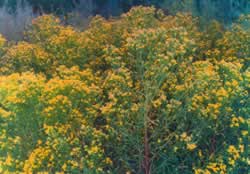 |
|
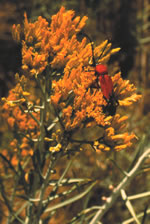 |
|
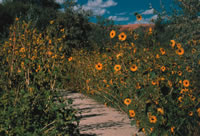 |
|
|
© 2001 Moab Happenings. All rights reserved. Reproduction of information contained in this site is expressly prohibited. |
|
 NATURE
HAPPENINGS
NATURE
HAPPENINGS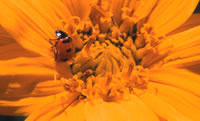 Late
summer does not bear the same profusion of desert wildflowers
that bloom in spring; however, there are a number of species
that grace the desert with their flowers this time of year.
And for that, we must thank the thunderstorms and the sunnies.
Late
summer does not bear the same profusion of desert wildflowers
that bloom in spring; however, there are a number of species
that grace the desert with their flowers this time of year.
And for that, we must thank the thunderstorms and the sunnies.